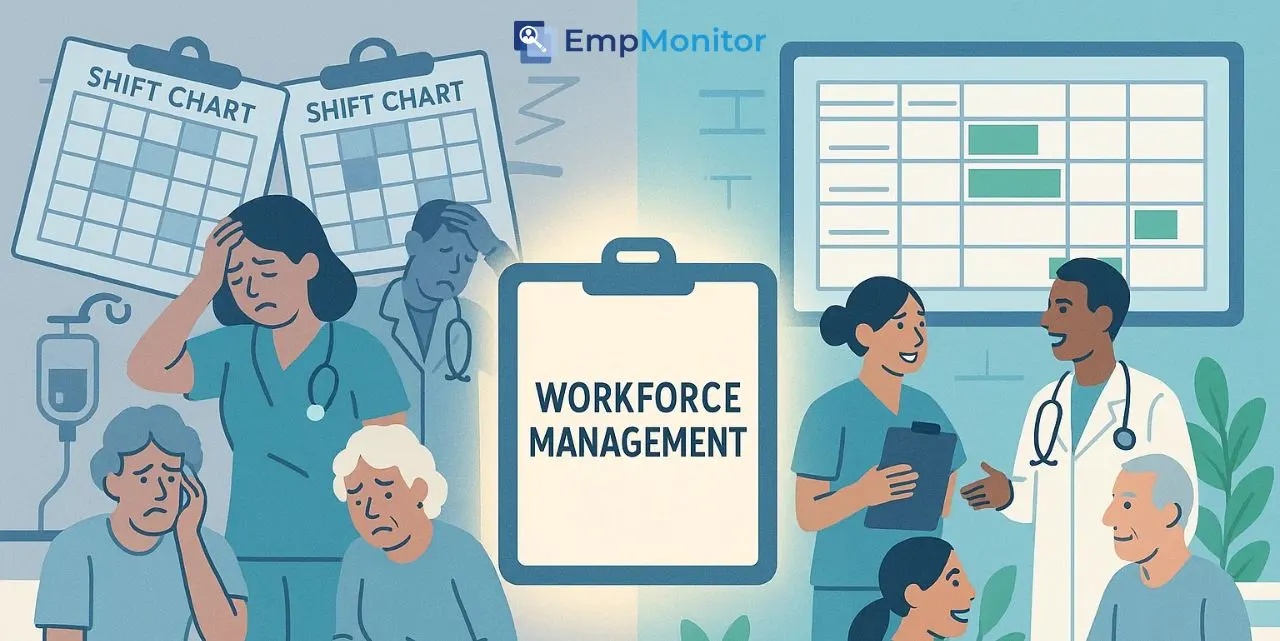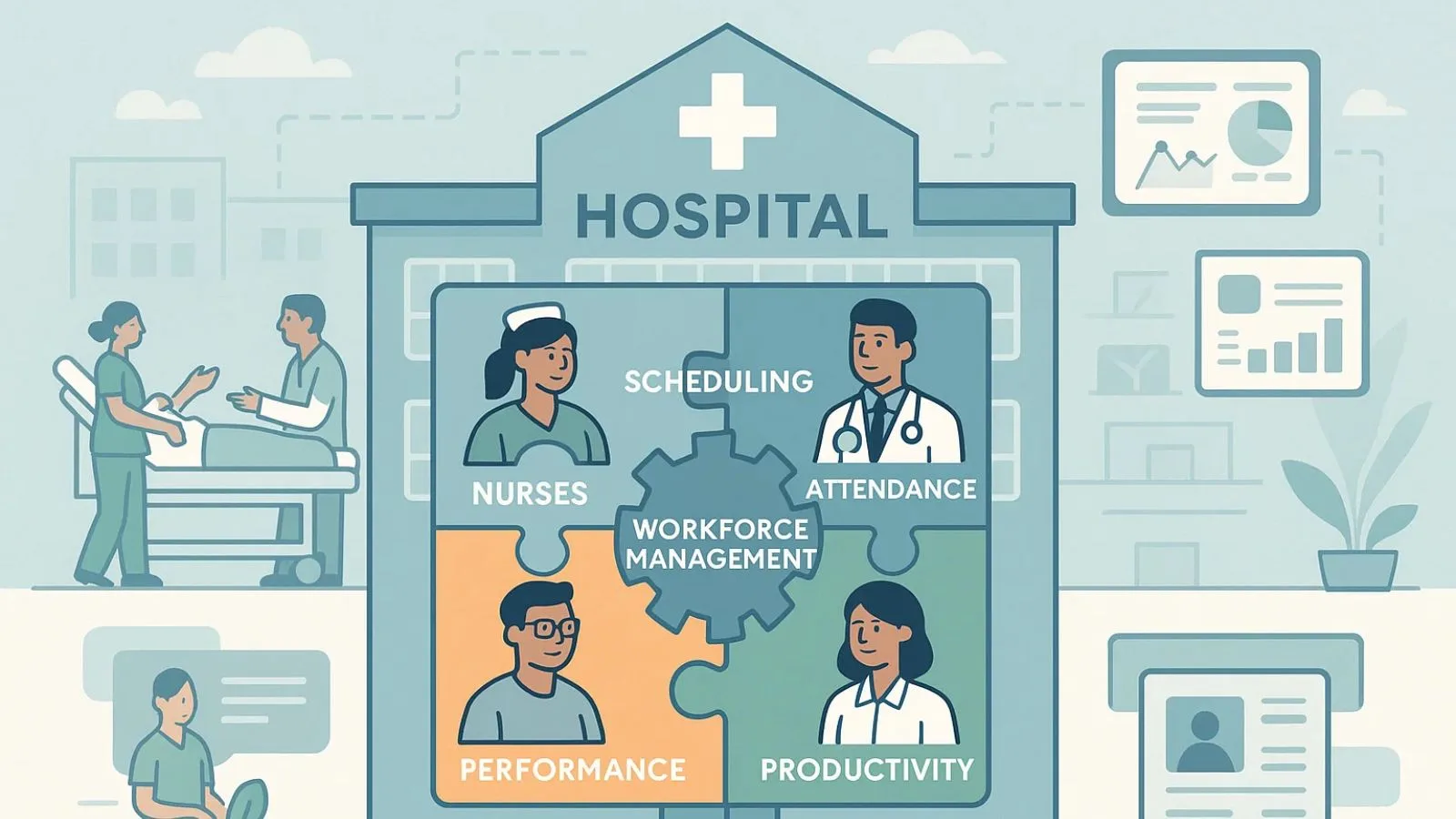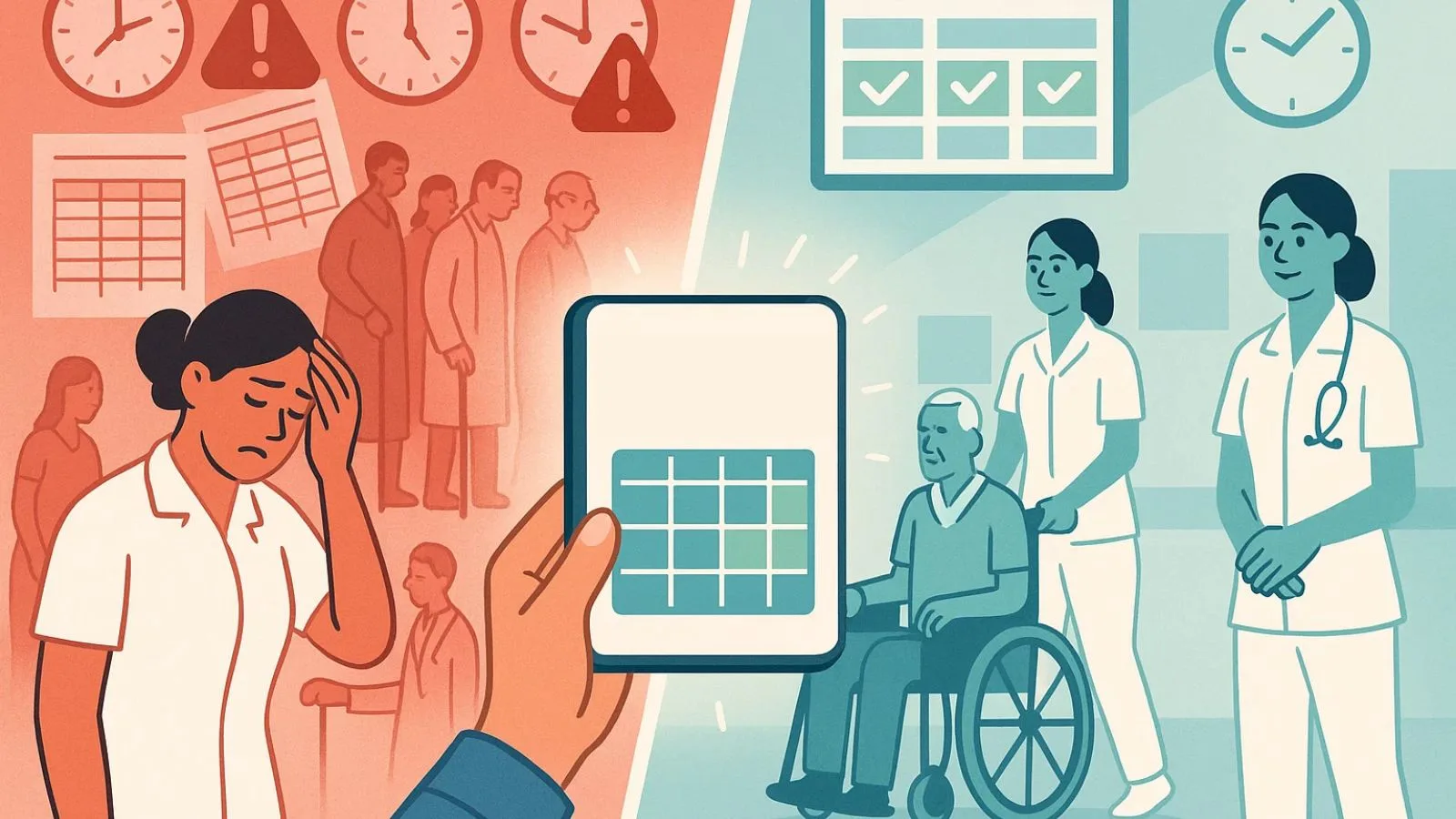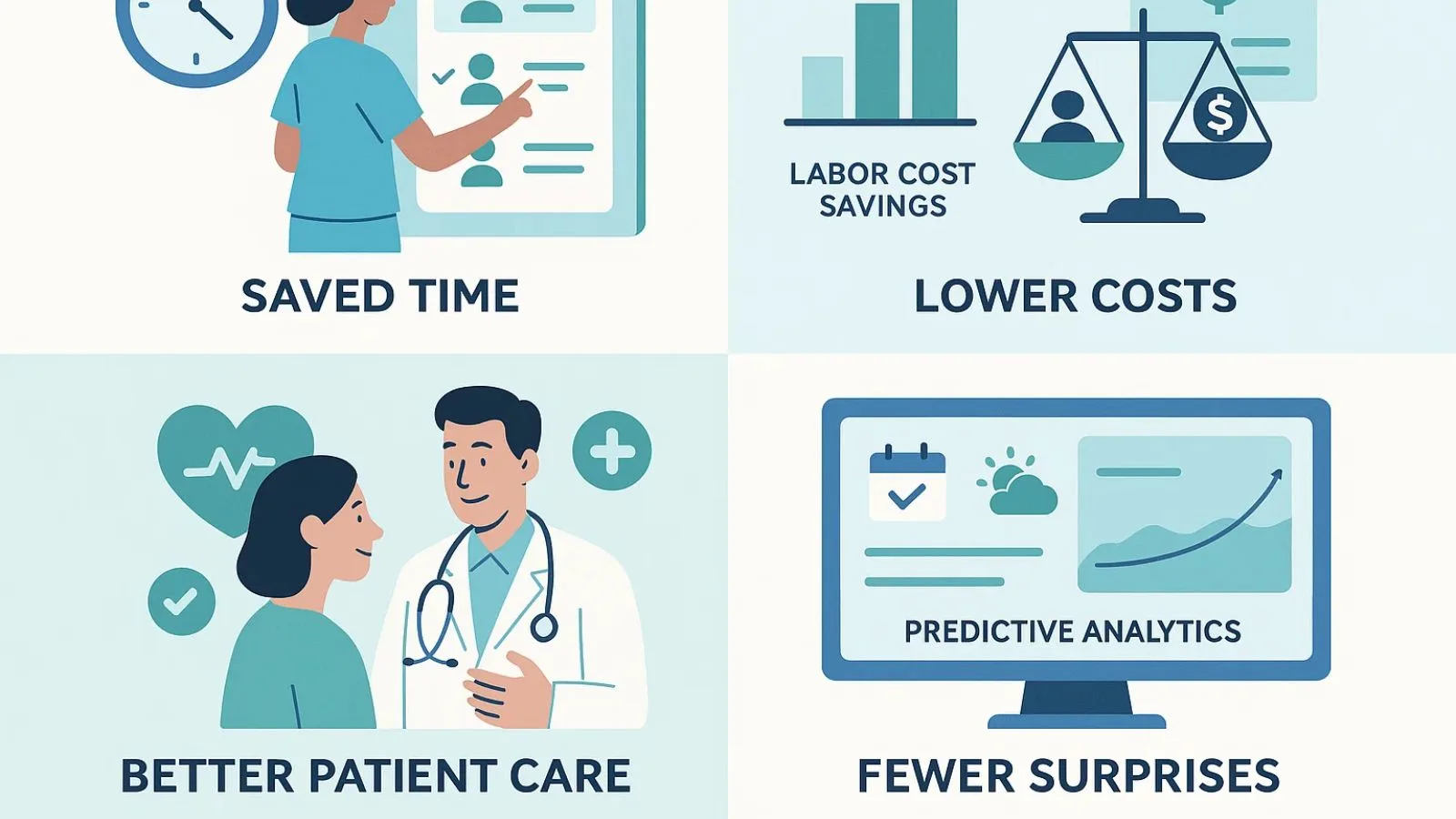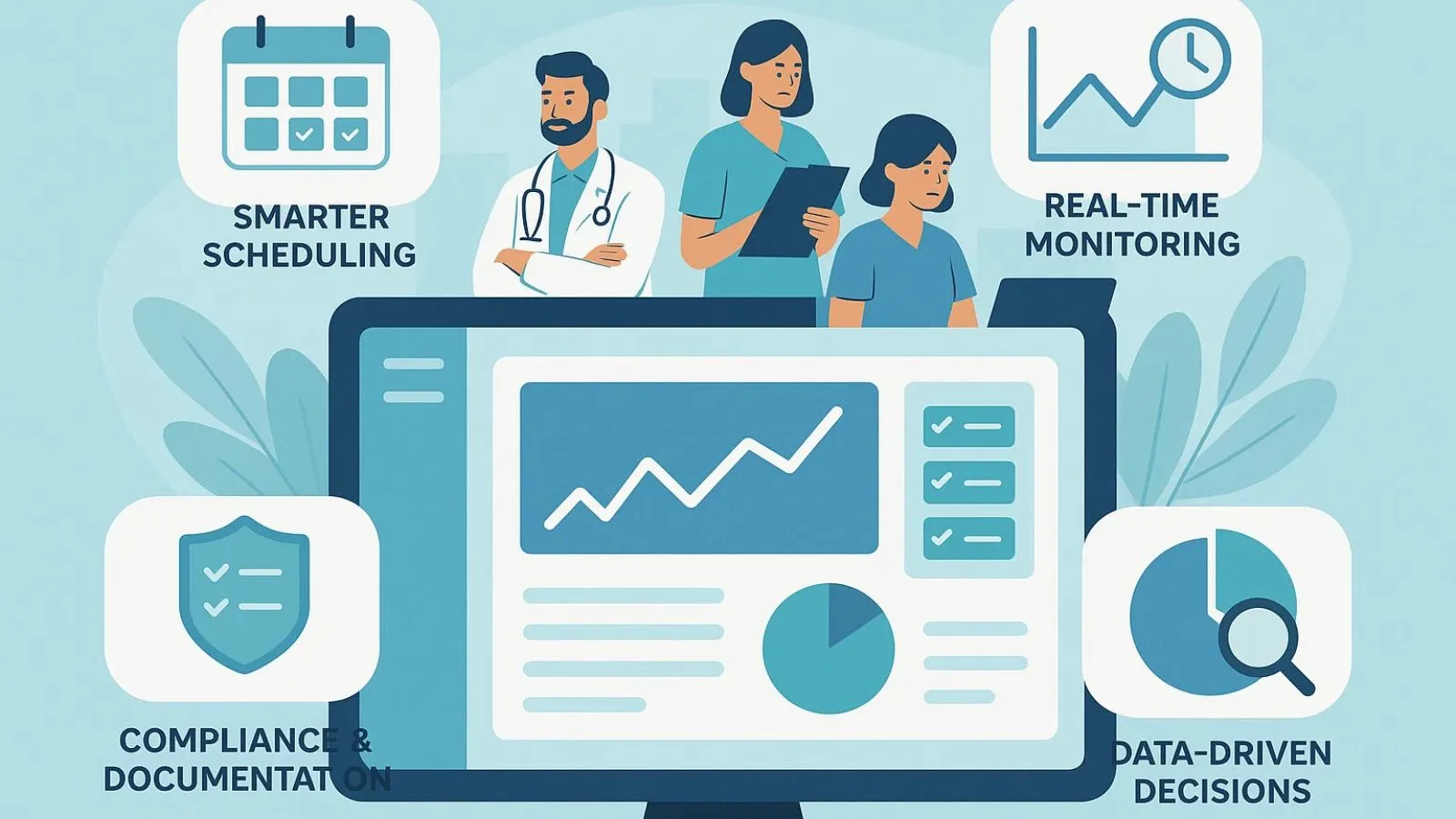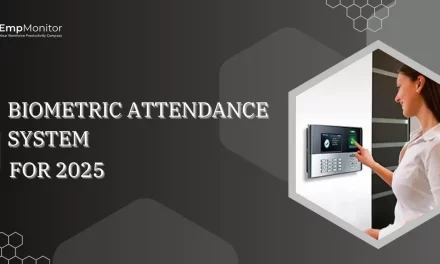Managing a healthcare facility today isn’t just about treating patients; it’s about managing people, time, and resources with precision and efficiency. Behind every successful hospital or clinic is a team working tirelessly to keep things running smoothly. But without the right systems in place, even the best teams can struggle.
That’s where healthcare workforce management steps in. It’s not just a fancy term; it’s a practical approach to organizing staff schedules, improving productivity, and delivering better care without burning out your team. As healthcare demands rise and staffing challenges grow, the need for efficient workforce management has never been more urgent.
In this blog, we’ll break down how healthcare workforce management can do more than just streamline operations; it can help you save time, reduce costs, and most importantly, improve patient outcomes.
You can Also Listen to our Blog here,
What Is Healthcare Workforce Management?
At its core, healthcare workforce management is all about making sure the right people are in the right place at the right time, without wasting time, money, or talent. It involves everything from scheduling shifts and tracking attendance to analyzing productivity and managing performance. For any healthcare facility, this means keeping operations smooth while ensuring staff aren’t overworked and patients aren’t underserved.
Think of it like a well-coordinated orchestra. Every nurse, doctor, technician, and support staff member plays a role. Without proper planning and coordination, even a small disruption can lead to longer wait times, errors, or staff burnout.
Healthcare workforce management doesn’t just apply to big hospitals; it’s just as crucial for clinics, senior care facilities, diagnostic centers, and even telehealth platforms. It’s the behind-the-scenes system that keeps the front-line team moving efficiently.
The goal is simple: to boost performance while maintaining care quality and compliance. In a time when healthcare systems are stretched thin, this kind of management isn’t optional anymore; it’s essential.
Contact Us
Why Does Healthcare Need Workforce Management?
Hospitals and healthcare centres are among the fastest-paced and high-pressure work environments. Between managing emergency cases, shift changes, compliance regulations, and patient satisfaction, things can get chaotic fast. That’s exactly why healthcare workforce management has become a non-negotiable necessity.
Preparing for these challenges starts with quality education; an MD program in medicine equips future healthcare professionals to thrive in such demanding settings.
One of the biggest challenges in healthcare today is staffing. There’s either too much staff on duty when things are slow (leading to wasted resources) or too few hands during peak hours (which causes stress, delays, and poor patient experience). Add to that rising burnout, high turnover rates, and increased patient loads, and you’ve got a recipe for inefficiency.
So, why does healthcare need workforce management? Because without it, facilities are forced to make reactive decisions that cost time and money. With the right workforce planning tools in place, organizations can create balanced schedules, forecast staffing needs, and reduce employee fatigue, all while keeping patient care front and center.
In short, workforce management solves problems in healthcare and ensures that operations are proactive, not reactive. It gives leaders the ability to manage people smarter, improving both productivity and care delivery.
Key Benefits of Healthcare Workforce Management
Investing in smart healthcare workforce management doesn’t just make life easier for HR or shift managers; it brings measurable results that impact the entire organization. From time savings to cost control and better patient outcomes, the right strategy can change how a facility operates day-to-day.
Let’s break down the major benefits:
1. Better Staff Allocation = Saved Time
When staffing is based on real-time demand, no one’s left sitting idle or scrambling to catch up. With accurate scheduling, tasks are distributed fairly, breaks are better planned, and time isn’t wasted dealing with last-minute changes. This helps things run more smoothly and gives staff more time to focus on patient care.
2. Cost-Efficient Scheduling = Lower Overhead
Overstaffing wastes budget. Understaffing risks patient safety. With effective healthcare workforce management, organizations can use historical and real-time data to schedule just the right number of people. This leads to optimized labor costs without sacrificing service quality.
3. Optimized Shifts = Better Patient Care
When staff are well-rested, focused, and not stretched too thin, patients notice the difference. Timely checkups, fewer errors, and better bedside manners all stem from well-managed teams. Healthcare workforce management makes sure staff energy is balanced and sustainable.
4. Predictive Planning = Fewer Surprises
Modern systems can predict how many patients will come in, changes during different seasons, or when staff might be absent. That means teams can plan instead of reacting to chaos. Predictive insights make healthcare systems stronger and more resilient.
Whether you’re managing a hospital, dental clinic, or home health service, the right healthcare workforce management approach brings structure, balance, and improved outcomes.
Challenges Without Proper Workforce Management
So, what happens when a healthcare facility doesn’t have a strong healthcare workforce management system in place?
In short, chaos.
Without clear scheduling, monitoring, and planning, healthcare teams are left to navigate a constant storm of unpredictability. And the consequences can be serious.
1. Staff Burnout and High Turnover
When schedules aren’t well-managed, employees get overworked, under-supported, and burned out. Healthcare professionals are already dealing with emotionally intense work; poor workforce management only adds to the pressure. This leads to higher resignation rates and staffing gaps that are hard to fill.
2. Overstaffing and Understaffing
Too many people on one shift wastes money. Too few can compromise patient care. Inconsistent schedules can lead to confusion, longer wait times, and even medical errors. These issues not only affect patients they also damage your facility’s reputation.
3. Patient Dissatisfaction
Longer wait times, rushed service, and stressed-out staff don’t go unnoticed. Without strong workforce planning, the patient experience takes a hit. In healthcare, a single bad experience can mean the difference between a patient’s trust and their hesitation to return.
4. Lack of Visibility and Control
When there’s no real system in place, management teams are left guessing. Who’s on leave? Who’s available to fill in? How much overtime are you paying for? Without centralized tools, answers are scattered, and decisions become reactive.
These challenges highlight why healthcare can’t afford to operate without proper workforce management. In the next section, we’ll explore how the right technology can solve these problems efficiently.
Role of Healthcare Workforce Management Software
Managing a modern healthcare workforce manually is like trying to run an ER with sticky notes; it’s just not sustainable. That’s where healthcare workforce management software plays a key role. These digital tools are designed to simplify and streamline everything from scheduling to performance monitoring.
Let’s look at how they help:
1. Smarter Scheduling and Shift Planning
Automated scheduling tools eliminate guesswork. You can assign shifts based on skill sets, availability, and workload, while avoiding conflicts and overtime. It also makes it easy to handle last-minute changes without disrupting the whole team.
2. Real-Time Monitoring and Reporting
With the right workforce monitoring software, managers can view attendance, track productivity, and monitor work hours in real time. This transparency helps identify bottlenecks, detect overworking, and address issues before they become bigger problems.
3. Compliance and Documentation
From labor laws to internal policies, healthcare organizations have to stay compliant. Workforce management software automates record-keeping, tracks certifications, and helps avoid legal risks through accurate documentation.
4. Data-Driven Decisions
Good software provides insights, not just spreadsheets. You get actionable analytics on staff performance, absentee trends, overtime usage, and more. This helps in long-term planning, budgeting, and improving overall efficiency.
Whether you’re running a small clinic or a multi-location hospital, healthcare workforce management solutions, supported by various services like healthcare BI consulting, reduce the complexity and make your team stronger, more agile, and better equipped to handle anything.
A Smart Solution for Smarter Healthcare Workforce Management
When it comes to managing a fast-paced healthcare environment, you need more than just spreadsheets and good intentions; you need a tool that gives you visibility, control, and insights in real-time. That’s exactly what EmpMonitor offers.
EmpMonitor is a powerful workforce monitoring software designed to help healthcare organizations manage their teams with ease, accuracy, and confidence. From tracking attendance to monitoring productivity, it gives you everything you need to run a lean, effective operation.
Why EmpMonitor Works for Healthcare Teams?
Real-Time Attendance Tracking
Know exactly when your staff clock in and out with detailed logs and automated reporting that saves HR hours of manual work.
Productivity Monitoring
Track how time is spent during shifts, spot inefficiencies, and support teams in staying focused without micromanaging.
Shift & Leave Management
EmpMonitor simplifies scheduling and makes it easy to manage shifts, leaves, and replacements from one centralized dashboard.
Custom Reports & Alerts
Generate data-driven insights on performance, idle time, or overtime so you can make informed decisions that keep operations smooth and compliant.
Whether you’re managing a hospital, urgent care center, or small clinic, EmpMonitor helps you implement modern healthcare workforce management software without the overwhelm. It brings clarity where there’s usually chaos.
Want to manage your healthcare team smarter, not harder?
Explore EmpMonitor and take control of your workforce today.
The Future Of Workforce Management In Healthcare
As the healthcare industry continues to evolve, so does the way we manage its most vital resource, people. The future of healthcare workforce management isn’t just about better tools; it’s about smarter, more human-centered strategies powered by technology.
Here’s what’s on the horizon:
1. AI-Driven Scheduling and Predictions
Advanced systems will soon use AI to analyze patterns and predict staffing needs, adjusting schedules automatically based on patient volume, staff availability, and even seasonal illness trends. This kind of proactive planning reduces last-minute stress and helps maintain balance.
2. Personalized Workflows for Staff
Instead of one-size-fits-all scheduling, future systems will personalize shifts based on individual preferences, energy levels, and performance data. This not only boosts satisfaction but also reduces burnout.
3. Integration with Telehealth and Remote Work
With telehealth becoming a permanent part of the healthcare landscape, workforce management systems are adapting to support remote roles. Whether it’s managing virtual consultations or hybrid care teams, software will play a key role in keeping operations seamless.
4. Smarter Compliance & Credential Tracking
Healthcare regulations constantly evolve. Future workforce management tools will automatically track certifications, training updates, and compliance requirements, reducing administrative burdens and legal risks.
The future is digital, intelligent, and people-focused. Facilities that adopt modern healthcare workforce management solutions today will be the ones leading with better care, stronger teams, and streamlined operations tomorrow.
Read More,
Why Do We Need Workforce Management Solutions To Grow?
Workforce Management, The Future of the New Era…
Conclusion
In the fast-paced world of healthcare, every second, every dollar, and every choice matter. That’s why managing the healthcare workforce isn’t just an administrative task; it’s a vital strategy.
From reducing staff burnout and controlling costs to improving patient care and ensuring compliance, effective workforce management touches every part of a healthcare organization. And with the right tools, like EmpMonitor, putting that strategy into action becomes much easier and more impactful.
By embracing modern solutions, healthcare providers can build stronger teams, avoid unnecessary stress, and focus on what truly matters: delivering excellent care.
So if you’re still relying on outdated systems, it might be time for a change.
Explore EmpMonitor.com and discover how you can manage your healthcare workforce with clarity, efficiency, and confidence.
FAQs
- What is workforce management in healthcare?
Healthcare workforce management refers to the process of efficiently scheduling, monitoring, and optimizing staff across healthcare facilities. It ensures the right people are in the right roles at the right time, improving care quality, reducing costs, and avoiding staff burnout. - How can workforce management reduce costs in hospitals?
By optimizing shift planning, reducing unnecessary overtime, and eliminating overstaffing, workforce management helps hospitals control labor costs. It also improves productivity, which lowers operational expenses in the long run. - Is there software specifically for healthcare workforce management?
Yes. Tools like EmpMonitor offer features tailored for healthcare teams, including real-time attendance tracking, productivity monitoring, shift scheduling, and compliance support, all in one platform. - Why does healthcare need workforce management?
Because healthcare environments are fast-paced and unpredictable. Without proper workforce management, staff burnout, scheduling chaos, and patient dissatisfaction become everyday issues. Efficient systems bring order, accountability, and improved outcomes. - Can workforce management software help reduce employee turnover?
Yes. By providing fair scheduling, workload balance, and performance visibility, workforce management tools help improve employee satisfaction. Happier staff are more likely to stay, reducing costly turnover. - Is workforce management only useful for large hospitals?
Not at all. Clinics, urgent care centers, diagnostic labs, and even home health agencies benefit from healthcare workforce management. Any organization with a team can improve efficiency using the right tools.

